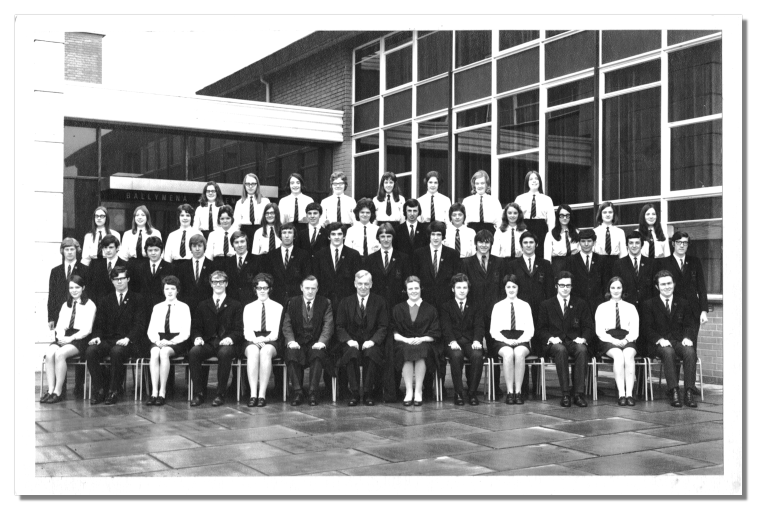“You’re suggesting we break into the school – when we’re about to break out!”

We are in the small front room of Joan’s house in Ballymena on a late April evening as the days lengthen. There’s a piano against the wall, we are sitting on the floor around a low table, a record player in the corner plays The Beatles “Let It Be”. The 1971 A-level exams are two months away, the end of classes some weeks before that. We are planning a stunt at the school, a farewell gesture, but not everyone is sure about it.
A week later and back in Joan’s house, all six of us are now on board with a plan to stage a short performance at morning assembly; the piano is central. We rehearse the piece many times until we are confident we can pull it off. It involves basic physics and electricity. Joan’s mother is never fazed when we regularly take her piano apart.
There is indeed a childish element to the prank, wanting to get our own back in some way. The headmaster of The Academy, Willie Moll, is an uncompromising disciplinarian. He has left a mark on all of us. If we get this right, maybe we can bring a smile to his face.
To set the piece up we must break into the school. There is a rumour that security dogs patrol nightly after other end-of-school pranks, but a teacher tells us otherwise.
At 2 am one cloudy night in May, with an occasional crescent moon breaking through, five of us gathered in a lane way on the edge of town. We carried the few items we needed over the cross-country track at the boundary, across the pitches and running track, up to the rear of blocky school building, hoping we haven’t been seen. The night is quiet except for the occasional bark of a distant dog. Climbing in through a changing room window left open earlier, we stepped into the empty school.
Quiet as mice we walked through the dark corridors, familiar yet errie. In the assembly hall we closed the blackout curtains and put on a few lights. We were nervous and a short break for tea and coffee from a vending machine helped settle us to the task. One of us kept a constant watch on the caretaker’s house some 200 yards away.
Forty-five minutes later we have modified the piano, set up the other equipment and putting everything back in place. We left no trace, no empty coffee cups, no signs of ever being there. Then we went out of the school and across the pitches by the same route, and home.
The Academy had a morning routine of assembly like many schools; a hymn, a prayer and announcements. The teaching staff in their black robes sit in rows behind the headmaster. He stands behind a small lectern out front. To the right of the stage as you looked on is the piano and the pianist. Heavy black curtains frame the stage left and right and students sit facing it.
Assembly should have livened up when the pianist, accompanying the hymn struck Middle C for the first time, but when she did nothing happened. After the hymn she is observed gently nudging the key, aware that something is not right on the piano.
The headmaster finished his announcements, glanced over his shoulder as the staff rise to leave, scanned the assembled pupils, raised himself on his toes and leaned forward to clearly announce “Cla.a..” as the pianist finally liberated Middle C and John Lennon’s guitar intro to “I feel fine” cut through the assembly hall from somewhere above the piano. Teachers still on the stage turned sharply, the pupils about to rise stopped, the headmaster froze.
“Baby’s good to me, you know
She’s happy as can be, you know
She said so
I’m in love with her and I feel fine”
A few seconds after the Beatles launched into “I Feel Fine”, up in the lighting rigging, two small boxes are pulled over by a thread wound around the record player’s spindle. Confetti spilled out in a colourful cloud, falling over the headmaster, over the stage and out onto the students on the floor.
The song played just over 2 minutes by which time the last pieces of confetti have fluttered to the floor. What took place during this time, we can only imagine.
Those of us, including Joan, that planned it and carried it out – and we were never caught – have had to satisfy ourselves with second-hand accounts, and in the story’s regular retelling. What we do know is that assembly that day broke up in a buzz of excitement and noise, never witnessed before.
Ends
The real P.P.P. + THE PREFECT’S PERFECT PRANK !
LikeLike
Good one Alistair. Thanks!
LikeLike